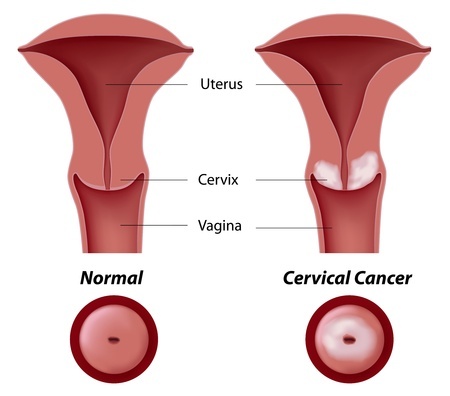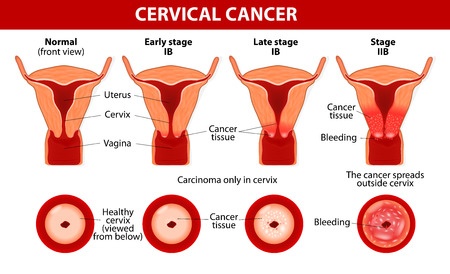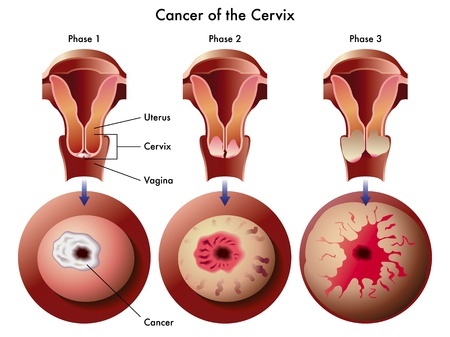The development of cervical cancer is associated with the infection by human papilloma virus (HPV). There are around 200 different types of papillomavirus, but some of them are particularly dangerous. It is estimated that the types 16 and 18 of papilloma viruses are behind 75% of cervical cancer cases. HPV is often considered as sexually transmitted disease, although most women infected even with most dangerous types of virus will not develop cervical cancer.

HPV vaccination is an effective way of reducing the risk of cervical cancer. Cervical screening by the Pap smear test helps in the detection of pre-cancerous stage of the disease and reduces the cervical cancer incidence by up to 80%.
Squamous cell carcinomas account for 80-85% of all cervical cancers, but there are multiple other versions of the disease. Exact diagnostics is important for successful treatment of this condition.
Cervical cancer is a highly treatable when detected early. The five-year survival rate is 92% for the patients at earliest stage of invasive cervical cancer. The overall 5-year survival for patients with all stages of disease is 72%.
Symptoms
At early stages, cervical cancer develops without any obvious symptoms. Quite frequently, the first symptom of cervical cancer is an abnormal vaginal bleeding.Other possible symptoms of cervical cancer may include:
- Vaginal discharge
- Moderate pain during sexual intercourse
- Loss of appetite and weight loss
- Pain in the legs, swollen legs
- Pelvic pain
- Pain in the lower back
- Presence of vaginal mass
- Leakage of urine from vagina.

Risk factors
Like with many other types of cancer, experts cannot point to the precise cause of cervical cancer in each individual case. However, certain factors are known to increase the chances of getting it:
- Infection with papillomavirus types 16 and 18
- Due to the disease association with infectious human papillomavirus, women with multiple sexual partners (or those who have man with multiple sexual partners) are at higher risk of developing cervical cancer
- Smoking increases the chances of developing the disease. Heavy smokers have 2.5 times higher chances of developing this disease
- Cervical cancer is more common among younger women
- Infections with genital warts, chlamydia and herpes simplex virus increase the chances of cervical cancer
- Immunosuppression caused by HIV/AIDS also increases the risk of disease.
Diagnosis
Vaginal bleeding is usually the first sign of the disease that prompts further evaluation. Diagnostic tests include the following:- Colposcopy – the procedure is performed with the use of colposcope, a special device that helps in visual inspection of the cervix. The samples of tissues can be taken for further analysis during this procedure.
- Ultrasound examination and CT scan – the procedures allow for the evaluation of the extent of the disease, including the presence and location of any existing metastases.
- Blood tests – the tests assess the levels of some tumor markers in the blood. Increased levels of these substances do not mean the patient has cancer, but help doctors in making a diagnosis.
- Analysis of biopsy tissue – the samples of suspicious tissues taken during colposcopy are assessed on the cancerous nature of the growth. This analysis allows a definite diagnosis of cervical cancer.

Treatment
The therapeutic approaches to cervical cancer treatment depend on the type and stage of the disease and on the patient’s overall health.
- Surgery: Hysterectomy, the removal of uterus and a part of vagina, is often performed to treat the disease. Surgical removal of the surrounding lymph nodes may also be conducted as a part of this procedure.A more conservative treatment, trachelectomy, is often performed in Israel for patients at early stages of disease. This surgical procedure is less invasive. It preserves the ovaries and uterus and is considered as a fertility sparing therapy.
- Chemotherapy and radiotherapy: The surgical intervention may be complemented by radiation therapy and chemotherapy. Cervical cancer is known to be radiosensitive, which means that it responds very well to radiation therapy. Chemotherapy of cervical cancer with the drug carboplatin is also considered efficient. This drug is often used in combination with other anti-cancer agents.











